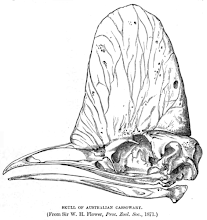being that it is the holiday season, i figure a discussion of the intricacies of edible fowl is in order.
on the menu: light vs. dark meat

i'm a vegetarian, but i'm not afraid to say that birds are delicious. i think that a lot of americans would agree with me: on thanksgiving alone, 45 million turkeys were consumed in the US. that's about a turkey for every seven people, holy smokes!

if you are a bird-eater, you have probably been asked if you prefer light or dark meat. the light meat is generally the breast and wing muscles, whereas the dark meat is the thigh and leg muscles. the difference in coloration is due to this baby:

myoglobin! myoglobin is a nifty protein found in the muscle fibers of vertebrates. it has a REALLY INSANELY high affinity for oxygen, which is integral in the proper functioning of mitochondria.

mitochondria are the bits in cells [organelles] that generate energy in the form of ATP [adenosine triphosphate]. nestled in the mitochondria are our myoglobin proteins, which supply the oxygen to the mitochondria as they "do what they do"
though they ARE the superstars of ATP production, mitochondria are not the end-all of energy-makin' in the cell. a process known as glycolysis occurs outside of the mitochondria, and while it doesn't produce a lot of ATP, it does have a redeeming factor: it doesn't need oxygen in order to make it! that's called anaerobic respiration.
here's a diagram with a lot of acronyms and big words differentiating the two:

the blue is what happens within the mitochondria [oxidative phosphorylation] and the rest is glycolysis.
okay, all this stuff is great and all, but i still haven't addressed the coloration difference. c'mon!
SO. as you may be able to see in the diagram of the myoglobin protein, myoglobin has an iron [Fe] molecule in the middle. iron has a reddish quality about it.

thanks, catherine1.ecvv.com, i'm sure it was really necessary to put your name all over that picture of pure iron powder! cool
anyway, in order to get at what i'm trying to get at, i'm going to put all the information i've presented in a neat little list:
1. myoglobin has a high affinity for oxygen and is found in mitochondria
2. mitochondria make a LOT of energy [ATP] using oxygen [oxidative phosphorylation]; the process of glycolysis makes some energy without oxygen
3. myoglobin is red due to an iron molecule
and a list of some knowns i will present right now:
1. turkeys use their legs a lot, and consequently need more energy in their thigh and leg muscles.
[=> oxidative phosphorylation provides most of the energy for the leg muscles in fowl]
3. breast muscles are not used very much by fowl, and thus do not need as much oxygen
[=> glycolysis provides most of the energy for breast muscles in these birds]
conclusion: light meat is light because it has less mitochondria [myoglobin], dark meat is dark because it has more.
HA! made you learn some stuff so i could make that simple little statement.
so, light or dark?



























